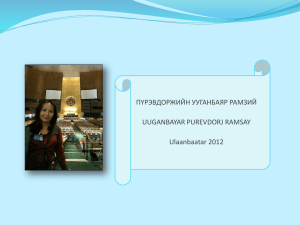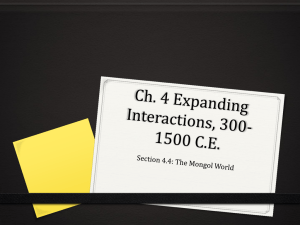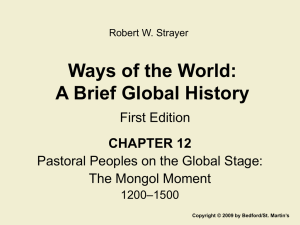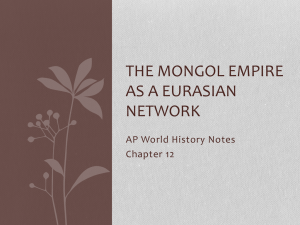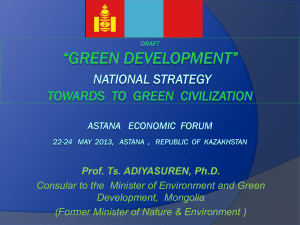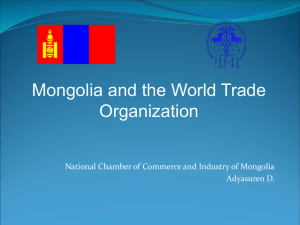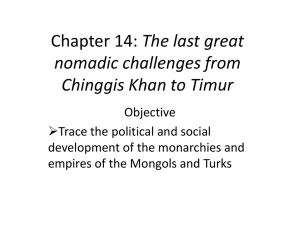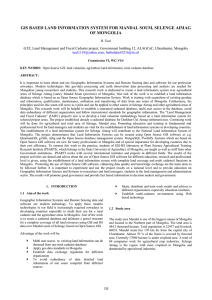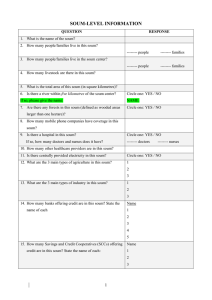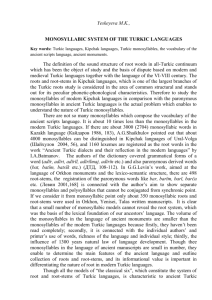Enkhtur Altangerel, Mongolian Academy of Sciences The Progress
advertisement
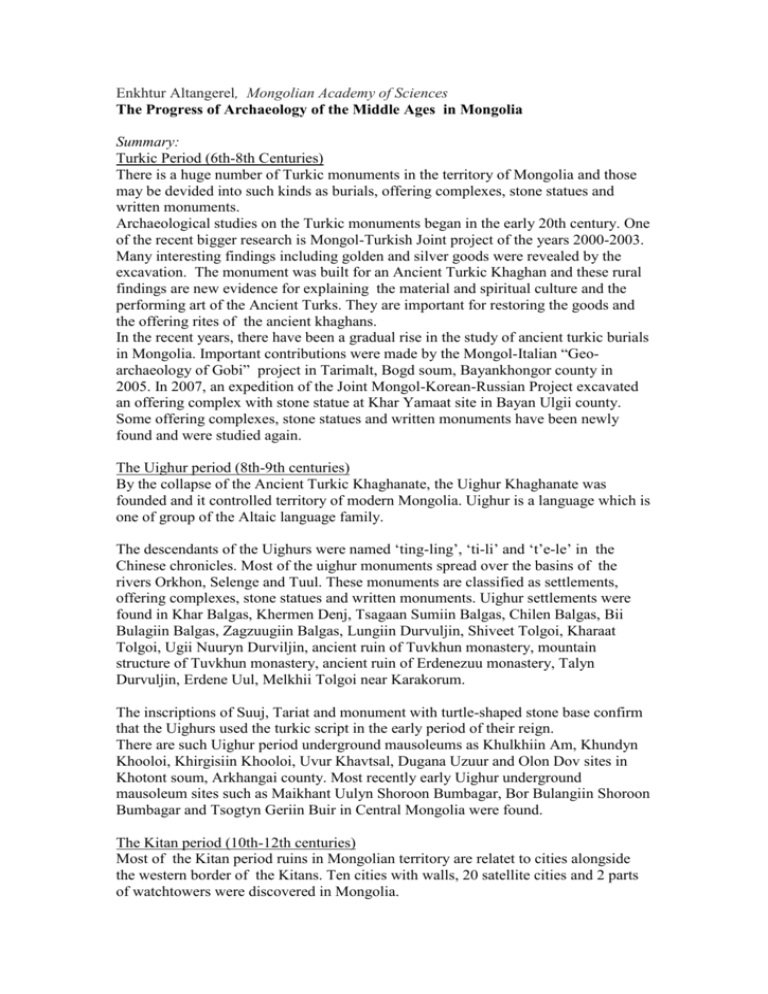
Enkhtur Altangerel, Mongolian Academy of Sciences The Progress of Archaeology of the Middle Ages in Mongolia Summary: Turkic Period (6th-8th Centuries) There is a huge number of Turkic monuments in the territory of Mongolia and those may be devided into such kinds as burials, offering complexes, stone statues and written monuments. Archaeological studies on the Turkic monuments began in the early 20th century. One of the recent bigger research is Mongol-Turkish Joint project of the years 2000-2003. Many interesting findings including golden and silver goods were revealed by the excavation. The monument was built for an Ancient Turkic Khaghan and these rural findings are new evidence for explaining the material and spiritual culture and the performing art of the Ancient Turks. They are important for restoring the goods and the offering rites of the ancient khaghans. In the recent years, there have been a gradual rise in the study of ancient turkic burials in Mongolia. Important contributions were made by the Mongol-Italian “Geoarchaeology of Gobi” project in Tarimalt, Bogd soum, Bayankhongor county in 2005. In 2007, an expedition of the Joint Mongol-Korean-Russian Project excavated an offering complex with stone statue at Khar Yamaat site in Bayan Ulgii county. Some offering complexes, stone statues and written monuments have been newly found and were studied again. The Uighur period (8th-9th centuries) By the collapse of the Ancient Turkic Khaghanate, the Uighur Khaghanate was founded and it controlled territory of modern Mongolia. Uighur is a language which is one of group of the Altaic language family. The descendants of the Uighurs were named ‘ting-ling’, ‘ti-li’ and ‘t’e-le’ in the Chinese chronicles. Most of the uighur monuments spread over the basins of the rivers Orkhon, Selenge and Tuul. These monuments are classified as settlements, offering complexes, stone statues and written monuments. Uighur settlements were found in Khar Balgas, Khermen Denj, Tsagaan Sumiin Balgas, Chilen Balgas, Bii Bulagiin Balgas, Zagzuugiin Balgas, Lungiin Durvuljin, Shiveet Tolgoi, Kharaat Tolgoi, Ugii Nuuryn Durviljin, ancient ruin of Tuvkhun monastery, mountain structure of Tuvkhun monastery, ancient ruin of Erdenezuu monastery, Talyn Durvuljin, Erdene Uul, Melkhii Tolgoi near Karakorum. The inscriptions of Suuj, Tariat and monument with turtle-shaped stone base confirm that the Uighurs used the turkic script in the early period of their reign. There are such Uighur period underground mausoleums as Khulkhiin Am, Khundyn Khooloi, Khirgisiin Khooloi, Uvur Khavtsal, Dugana Uzuur and Olon Dov sites in Khotont soum, Arkhangai county. Most recently early Uighur underground mausoleum sites such as Maikhant Uulyn Shoroon Bumbagar, Bor Bulangiin Shoroon Bumbagar and Tsogtyn Geriin Buir in Central Mongolia were found. The Kitan period (10th-12th centuries) Most of the Kitan period ruins in Mongolian territory are relatet to cities alongside the western border of the Kitans. Ten cities with walls, 20 satellite cities and 2 parts of watchtowers were discovered in Mongolia. Mongolian-Japanese archaeological team has studied Chin Tolgoy site in Dashinchilen soum of Bulgan province. The joint team have discovered several news about Kitans` production technology, wall structure and manufacture as well as studied the entrance of the wall, the earthenware chimney and the city environment. The geographical position of the Kitan ruins in Mongolia is organized from the west to the east. For example, Kherlen bars-1, Zuun Kherem, Baruun Kherem, Oglogchyn Golyn Kherem, and Ulaan Kherem, Chin Tolgoyn Balgas, Chilen Balgas, Khar Bukhyn Balgas, Emgentyn Kherem in Tuul river and Orkhon river basin can be included in it. These ruins are located at 15-30 km distance from each other. Satellite cities and watchtowers are organized within each ruins. The archaeological excavations contributed much to our understanding of the Kitans' life. The Mongol Period (12th-14th centuries) Mongol tribes dwelt in the territory between the contemporary Great Wall of China and the upper Selenge in 12th century, after the collapse of the Kitan Empire. The Khamag Mongol Chiefdom founded the Great Mongol empire, becoming more powerful and uniting all Mongol tribes in the beginning of the 13th century. Monuments belonging to period of the Mongol Empire can be classified as settlements, burials, stone statues and written monuments. In the recent years, Mongol-German and Mongol-Japan joint expeditions carried out more important excavations in the ruin of Karakorum and the site of Auraga where Chingis Khan’s Great Horde was located. Having excavated the main parts of the city, the Karakorum expedition utilized such modern methods and technologies as making specific topografic maps, geophysical researches and natural sciences analyzes for dating artefacts. As a main result of the archaeological studies on Karakorum, a central big building of a complex was examined by whole-scale excavation. The building used to be described as ‘Ögödei Khan’s Palace’ during many years and its date, structures and organization were specifically determined. Burials of Mongol period are divided into two main groups as ‘stone mounded buirals’ and ‘rock burials’. The Mongol-American Joint expedition of “Survey in South Gobi” project has excavated sites of Baga Gazryn Chuluu since 2006. Other expedions of the Institute of Archaeology, MAS carried out excavations in the territory of Khan Bogd and Tsogt Tsetsii soums of Umnugobi county since 2008 and at Khutag Undur soum, Bulgan county in 2011. Mongol archaeologists excavated 8 of the burials of the Mongol Period site Tavan Tolgoi in the territory of Ongon soum, Sukhbaatar county. Some wonderful artefacts including arm-chair, full suit of armour, golden top and engraved ornament of headdress, inscribed bone seal, wooden musical instrument were found by this excavation. Rock burials have been found in the following sites: Ikh Nartyn Chuluu in Dundgobi county, Ikh Khushuut in Bayan Ulgii county, Rashaant, Artsat Del, Shiveet Tsankhir in Bayankhongor county, Shiluustei soum in Zavkhan and Chonot Uul, Bulgan Uul in Bulgan soum, Khovd county. The Archaeology of Mongolia's Middle Ages begun to be studied by teams from Holland, Japan, Russia, Germany, China, Korea and the USA. We hope that we are now at a new stage of studying "the Archaeology of Mongolia's Middle Age".
